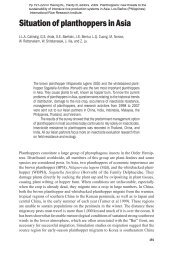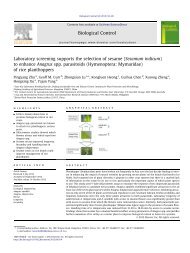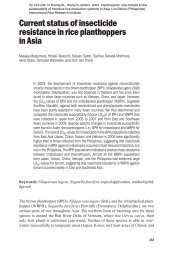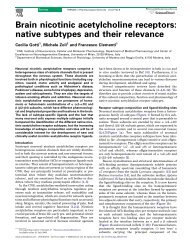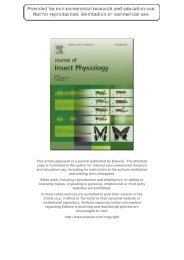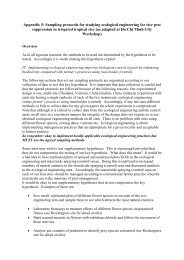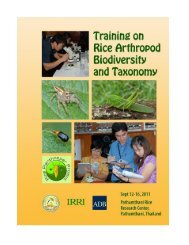Fujita, D. et al. 2009. The genetics of host-plant ... - Ricehoppers
Fujita, D. et al. 2009. The genetics of host-plant ... - Ricehoppers
Fujita, D. et al. 2009. The genetics of host-plant ... - Ricehoppers
- No tags were found...
Create successful ePaper yourself
Turn your PDF publications into a flip-book with our unique Google optimized e-Paper software.
Pp 389-400 IN Heong KL, Hardy B, editors. <strong>2009.</strong> Planthoppers: new threats to thesustainability <strong>of</strong> intensive rice production systems in Asia. Los Baños (Philippines):Internation<strong>al</strong> Rice Research Institute.Table 2. <strong>The</strong> ratio <strong>of</strong> fem<strong>al</strong>es with swollen abdomen <strong>of</strong> the Asian BPH strains collectedin 2006 on differenti<strong>al</strong> cultivars in rice.CultivarBPH strainJPN CHI TW RRD1 RRD2 MRD1 MRD2 LZ1 LZ2 MDMudgo 94 74 77 100 91 91 83 80 86 40ASD7 91 86 80 97 94 94 83 87 89 57Rathu Heenati 0 0 0 0 0 0 0 0 0 0Babawee 6 14 9 0 0 63 37 14 17 14ADR52 0 0 0 0 0 51 23 0 0 0B<strong>al</strong>amawee 0 0 0 0 0 0 0 0 0 0T65 (check) 91 80 83 94 97 86 83 86 91 74Monitoring BPH virulence using rice NILsTables 3 and 4 show that the adult surviv<strong>al</strong> rate and ratio <strong>of</strong> virulent fem<strong>al</strong>es <strong>of</strong> 10Asian BPH strains on the NILs and PYL carrying BPH resistance genes are derivedfrom ADR52. Based on the resistance spectrum to NILs and the PYL for bph20(t) andBph21(t), the Asian BPH strains seem to be classified into four groups. <strong>The</strong> first groupis avirulent to <strong>al</strong>l the tested lines. <strong>The</strong> second group is virulent to the Bph21(t)-NIL butavirulent to the bph20(t)-NIL and bph20(t) + Bph21(t)-PYL. <strong>The</strong> third group is virulentto both the bph20(t)-NIL and Bph21(t)-NIL but avirulent to bph20(t) + Bph21(t)-PYL.<strong>The</strong> fourth group is virulent to <strong>al</strong>l tested lines. <strong>The</strong> first group is the Mindanao strain,which could not adapt to any lines. <strong>The</strong> second group consisted <strong>of</strong> BPH strains fromChina and Taiwan. <strong>The</strong> third group consisted <strong>of</strong> BPH strains from Japan and northernVi<strong>et</strong>nam and two Luzon strains from the Philippines. <strong>The</strong> discrimination b<strong>et</strong>ween thesecond and third groups is still ambiguous because <strong>of</strong> differentiation among the BPHstrains from China, Taiwan, and Japan as well as northern Vi<strong>et</strong>nam, which have neverbeen identified. <strong>The</strong> fourth group consisted <strong>of</strong> BPH strains from southern Vi<strong>et</strong>nam;those were the most virulent and h<strong>al</strong>f <strong>of</strong> the adult fem<strong>al</strong>es had swollen abdomens onthe PYL within 5 days. <strong>The</strong> results indicate that both <strong>of</strong> the BPH resistance genes,bph20(t) and Bph21(t), are necessary to express broad-spectrum resistance againstEast Asian BPH strains. <strong>The</strong> PYL, however, had lost its resistance against the southernVi<strong>et</strong>nam strains <strong>of</strong> BPH. Monitoring the virulence <strong>of</strong> BPH strains using NILs andPYLs will open the door for the use <strong>of</strong> BPH-resistant cultivars and sustainable pestmanagement in Asian rice fields.396 <strong>Fujita</strong> <strong>et</strong> <strong>al</strong>



